Global Exodus from the US Dollar is in Motion
Currencies / US Dollar Jul 03, 2007 - 04:05 PM GMTBy: Gary_Dorsch
 Trading in the arcane world of foreign exchange is often akin to judging a reverse beauty contest. The trick to profitable trading is to pick the least ugly currency. Nearly all fiat or paper currencies are ugly, because the 18 of the world's top-20 central banks are inflating the money supply at double digit rates. At the moment, the world's two ugliest currencies are the Japanese yen and the US dollar.
Trading in the arcane world of foreign exchange is often akin to judging a reverse beauty contest. The trick to profitable trading is to pick the least ugly currency. Nearly all fiat or paper currencies are ugly, because the 18 of the world's top-20 central banks are inflating the money supply at double digit rates. At the moment, the world's two ugliest currencies are the Japanese yen and the US dollar.
The Bank of Japan pegs its overnight loan rate at just 0.50%, in a brazen effort to devalue the yen, to boost exports abroad, and prevent an abrupt unwinding of the mushrooming “yen carry” trade. Meanwhile the Federal Reserve is inflating its M3 money supply at a 13.7% annualized clip, according to private economists, which if correct, would be the fastest rate of expansion in more than 30-years.
US Treasury chief Henry Paulson, and former chairman of Goldman Sachs, GS.N, “monitors the financial markets closely,” and has reinvigorated the infamous “Plunge Protection Team,” which comes to the rescue of the US stock market whenever nasty revelations come to the surface. At the moment, Paulson's grand strategy is to offset losses in the US housing sector with big gains in the stock market, to prevent the US economy from sliding into recession.

A key player in the “Plunge Protection Team” (PPT) is none other than Federal Reserve chief Ben “helicopter” Bernanke. Since the Bernanke Fed discontinued the decades-old reporting of the broad M3 money supply in March of 2006, the growth rate of M3 has accelerated from an 8% rate to a sizzling 13.7% clip, its fastest in more than three decades. The Bernanke Fed is preventing borrowing rates from rising at a time of explosive loan demand for US corporate mergers and takeovers, by rapidly increasing the US money supply.
The Bank of America, Citigroup, and JP Morgan led US loan underwriting in the first half of 2007, which totaled $943 billion, up 5.4% from a year earlier. Global mergers and takeovers soared to an astronomical $2.78 trillion during the first six months of the year, up 51% from a year ago, led by $1.05 trillion in the US alone. Buy-outs by private takeover artists soared 23% to a record high of $568 billion in H'1 2007, with 35% of US takeovers, and 13% of European takeovers financed with debt.
But one sector of the US stock market which has not responded positively to the Fed's heavy injections of monetary steroids has been the home builders, once regarded as a top bull-market leader from 2003 thru August 2005. The Dow Jones Home Construction Index, a yardstick that measures home builder performance, is off 25% this year, and is flirting with key support at the 525 level, which if penetrated, would be especially bearish.
On July 2nd, Paulson sent a discreet signal to Wall Street power-brokers to avoid dumping the home builders. “In terms of housing, it's had a significant impact on the economy. No one is forecasting when, with any degree of clarity, that the upturn in housing is going to come, other than it's at or near the bottom.
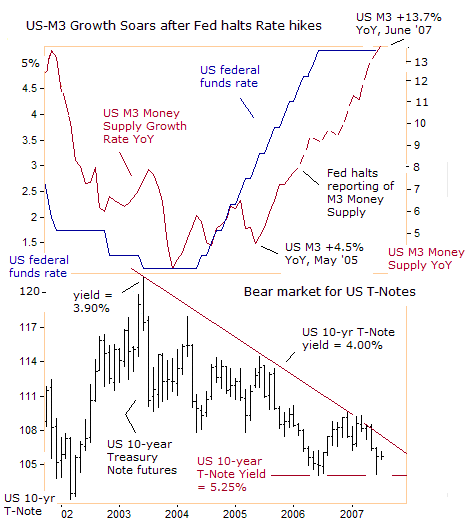
The Fed has obscured its money printing operations by discontinuing the reporting of M3, in order to limit the damage to the fixed income markets. But word of the explosive growth of the M3 money supply is slowly leaking out, and taking its toll on the US Treasury Note market, which briefly tumbled to its lowest level in five years in June, lifting 10-year yields as high as 5.30%, before receding back to 5.00%, on a “flight to safety” from the riskiest of the sub-prime home loan market.
Because the US credit markets are swimming in a tidal wave of rising liquidity, there will always be bargain hunters who are happy to park excess cash into the bond market whenever yields surge higher. Asian central banks and Arab Oil kingdoms in particular, have been big buyers of US T-bonds over the past four years, and hold roughly $1.3 trillion of the IOU's, but even this massive intervention couldn't turn the tide of the four-year bear market.
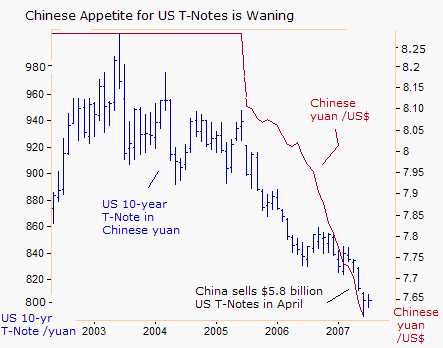
But now there are indications that China's insatiable appetite for US T-bonds is waning. Beijing was a net seller of $5.8 billion of US T-bonds in April, the first drop in Chinese holdings since October 2005, and sparking the recent slide that lifted 10-year yields by 70 basis points, at its high mark. Since Beijing unhinged the dollar from a fixed peg of 8.27 yuan in July 2005, the value of the US 10-year T-note, when converted into yuan, has declined by 15 percent. Earlier today, the dollar slipped to 7.59 yuan, or 8.9% lower since the yuan was freed from the dollar peg.
If Beijing understood the full extent of the Fed's money printing operations, it might think twice about putting its hard earned dollars into Treasury IOU's. Beijing is almost guaranteed to take further losses on its massive $900 billion US bond portfolio, with its secret agreement with Paulson, limiting the dollar's annual devaluation against the Chinese yuan to 5%, to avoid the US Treasury's label of a currency manipulator.
China to diversify future FX Reserves away from US dollar
But China's old guard is finally waking up to reality, and looking for new ways to invest its bulging foreign currency reserves. China's FX reserves have more than tripled in three years after rising $209 billion in 2005, $207 billion in 2004 and $117 billion in 2003, and in the first quarter of 2007 alone, its treasure chest was bloated by a whopping $136 billion to a record $1.2 trillion.
Last Friday, the National People's Congress authorized the Ministry of Finance to set-up the State Investment Company, (SIC), which will invest $200 billion of the country's FX stash, into publicly listed companies, real estate, or private deals around the globe. Mostly likely, at the bottom of the list of possible Chinese investments are US Treasury bonds, which are a losing proposition due to heavy pressure for a further slide of the US dollar against the yuan.
The Ministry of Finance plans to issue 1.55 trillion yuan ($203.49 billion) of bonds to the People's Bank of China (PBoC), in a swap for the FX reserves that will be managed by a new investment fund. But the PBoC is also authorized to re-sell the giant bond offering, which would mop-up liquidity in the Shanghai money markets. If the PBoC parcels out the entire block of bonds, it would have the same effect as lifting the bank reserve requirements by 10 times with a magnitude of 0.5% each.
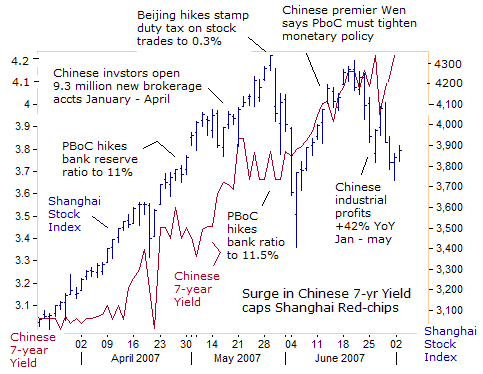
The sale of 1.55 trillion yuan of these special bonds would be equivalent to more than 50% of the government's 2.9 trillion yuan outstanding debt. China's parliament also authorized the State Council to abolish or reduce the 20% withholding tax levied on interest income. The measure is aimed at staunching the flow of cash into the surging stock market by making bank deposits more attractive.
Cancelling the tax entirely would be the equivalent to an increase in the after-tax one-year deposit rate of about 60 basis points, while a 50% reduction would boost after-tax interest by about 30 basis points. It would also increase the after-tax interest rate on China's 7-year bond by as much as 80 basis points. Already, China's 7-year bond yield has climbed 120 basis points to 4.22% since April 2nd, and now the central bank has new tools to drain liquidity from the money markets.
Higher Chinese interest rates have put a roadblock before the powerful Shanghai red-chip index, which has found stiff resistance at the 4,300 level, but finding support at 3,700. “China should appropriately tighten monetary policy to prevent relatively fast economic growth from overheating, and maintain stability,” the People's Bank of China said on July 3rd. The PBoC said it “would resort to a range of monetary policy tools to achieve reasonable growth in money and credit.”
With higher after-tax interest rates on Chinese bonds, and pressure on the Fed to lower the fed funds rate due to the sub-prime home loan meltdown, hot money from abroad should continue to flow into the Chinese yuan, greasing the skids for the US dollar's slide against other Asian currencies, such as the Korean won.
Bank of England – Pioneer of “Asset Targeting”
Just about every major central bank has a big credibility problem, when it comes to maintaining the purchasing power of its currency. The Bank of England, for instance, has tolerated double-digit growth of its M4 money supply for the past two years. The BoE is the “Group of Seven's” original pioneer in “asset targeting,” or guiding the stock and real estate markets to higher levels, by injecting excess liquidity into the markets, until asset prices reach the bank's targeted levels.
The BoE has guided the Footsie-100 from a low of 3,500 in Q'1 of 2003, to a 7-year high above 6,600 this month. But the BoE's monetary abuse that has taken place over the past few years, is taking its toll on the British debt markets, where the benchmark 10-year gilt fell to a 7-year low in June, lifting its yield to as high as 5.55%, before bargain hunters came out of the woodwork.
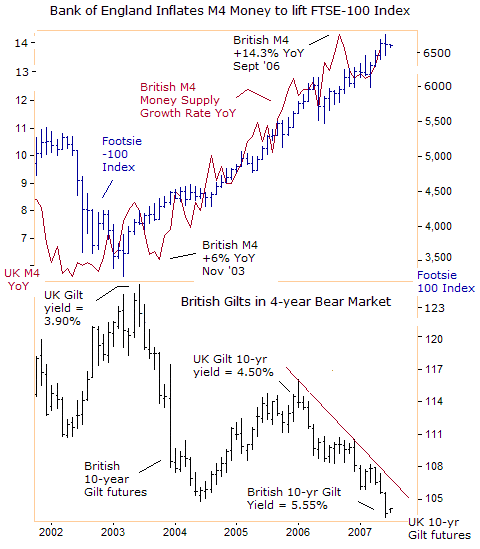
“Investors are likely to take advantage of this ample liquidity and the associated easy credit to purchase other assets, driving risk premia down and asset prices up," the BoE said in a February 20th, report for parliament's Treasury Committee. “In due course, those higher asset prices may be expected to feed through into higher demand for goods and prices, putting upward pressure on the general price level.”
In a speech to mark the tenth anniversary of the central bank's independence, BoE chief Mervyn King said on May 2nd, “It is unfortunate, if monetary developments are given insufficient attention in the analysis of the inflation outlook. The growth of money and credit may signal in advance of other indicators that the Bank rate is set at a level inconsistent with bringing inflation back to the target in the medium term.
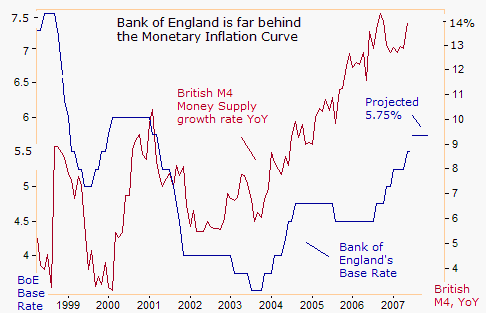
The BoE is well aware of the inflationary consequences of double-digit money supply growth, and London futures markets are pricing in two BoE rate hikes to 6% in the days and months ahead. But the BoE must still overcome stiff political opposition to higher borrowing costs, namely from newly installed prime-minister Gordon Brown. “Rigid monetary rules that assume a fixed relationship between money and inflation do not produce reliable targets or policy,” Brown argued on June 14th.
Such reckless comments by Mr Brown, are reminiscent of his decision to sell off more than half of the UK's centuries-old gold reserves in May 1999. The decision to sell 400 tons of gold is seen in City circles as a financial bungle on the scale of the Tories' “Black Wednesday” that cost the taxpayer 3.3 billion pounds. Brown offloaded the gold at a 20-year low in 17-auctions between $256 and $296 /oz, with an average of $275 /oz. Since then gold has risen sharply and stands around $650 /oz.
Judging from the chart above, the BoE is still far behind the monetary inflation curve, and would have to hike its base rate by 100 basis points to 6.50% or higher, to rein-in M4 growth into single digits. Ultimately though, the pressure on the BoE to hike interest rates further will come from the gilt market, which is in danger of a nasty meltdown, unless the central bank lives up to expectations of future rate hikes.
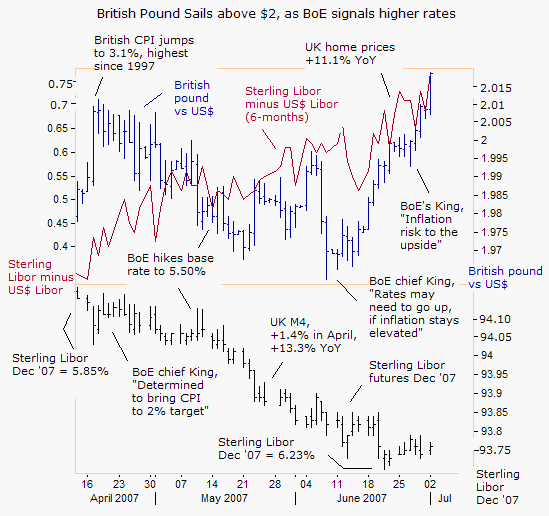
Mitigating some of the pressure for sharply higher BoE rates however, is the strength of the British pound, which climbed above the psychological $2 mark last week, for only the second time since 1980. The British pound is being driven higher by widening interest rate differentials moving in its favor, with the Federal Reserve handcuffed by a weakening housing market and a sub-prime loan debacle.
Both the British pound and US dollar are heavily inflated currencies. Both offer large external trade deficits and big budget deficits. While the Fed is inflating its M3 money supply at a 13.7% clip, the Bank of England is inflating its M4 at a 13.9% annualized clip. But the US economy is roughly six times the size of England's, so in absolute terms, the increase in supply of US dollars is much larger. And with the BoE expected to lift its lending rates to 75 basis points above the US$ rate, the pound is winning this “reverse beauty” contest.
Aussie Dollar Shines with Yield hungry Investors
After breaking thru the long held psychological barrier of 80 US-cents in March, one has to go back 18-years to find the last time the Aussie dollar traded as high as 86 US-cents. There are several reasons why the Aussie dollar is climbing sharply higher against the greenback, but the most commonly cited is higher yields. Yesterday, the yield on Australia's 10-year Treasury bond was +122 basis points (bp) higher than comparable yields on the US T-Note, up from +56 bp in April 2006.
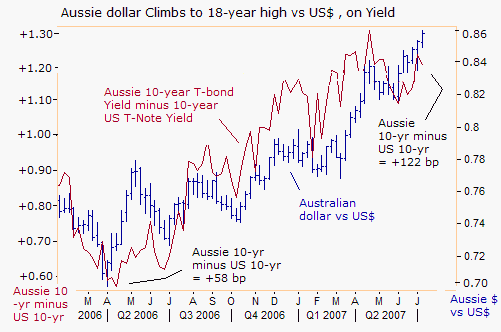
Interest rate differentials play a big role in the FX “reverse beauty” contest, and the Aussie has been underpinned by its relatively attractive yield. Yet why are Aussie bond yields rising relative to US yields? Flush with cash after a string of budget surpluses, the Australian government issues barely enough new paper to cover rolling maturities, keeping bonds outstanding at just A$60 billion, and down from around A$94 billion when Prime Minister John Howard came to power in 1996.
That is in sharp contrast to the United States where total public debt has ballooned by 50% since the turn of the century to reach $8.8 trillion. Issuance of marketable Treasury paper has likewise surged to $5 trillion, with $1.2 trillion of that held by offshore central banks. Aussie T-bonds offer the same triple-A rating, and with an appreciating currency, one might have expected Aussie yields to shrink relative to US T-Note yields. This Aussie yield spread is one of the market's great mysteries.

The Reserve Bank of Australia (RBA) isn't thrilled about the sharply higher Aussie dollar, which is bound to hurt exporters and widen the current account deficit, which jumped 20% to A$15.1 billion in Q'4, the largest quarterly shortfall on record, with the 12-month rolling total equal to 5.9% of the country's GDP. The RBA intervenes every month to sell Aussie dollars and slow its upside gains.
In the game of competitive currency devaluation with other central banks, the RBA has allowed its M3 money supply to expand at a 14.1% annualized rate, pumping up the local stock market but undermining confidence in the Treasury bond market. Aussie 10-year bond yields rose above the psychological 6% level in June, for the first time in five years.
In order to rein in the explosive growth of Aussie M3, the RBA would probably be required to hike its cash rate by 100 basis points to 7.25%, but that could send the Aussie dollar soaring into orbit against the Japanese yen, its top trading partner. Thus, the RBA's anti-inflation fighting capability is held hostage by the Bank of Japan, which won't lift its interest rates into alignment with the rest of the world.
Indirectly, the BoJ is exporting inflationary pressures into the Australian economy, with its super-low interest rate, and cheap yen policy. In turn, Aussie 10-year bond yields are rising faster than Japanese bond (JGB) yields, lifting the spread to +430 bp over JGB's, and catapulting the Aussie dollar to a 16-year high of 105-yen.
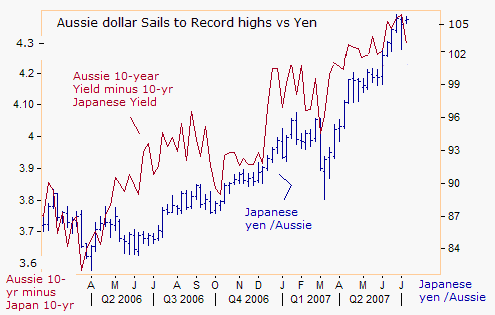
Japanese fixed income investors have become an integral part of the infamous “yen carry” trade, purchasing a large block of Australia's outstanding A$521 billion of foreign debt, seeking to profit from the yen's devaluation. But should the BoJ start to lift its interest rates to narrow the gap with the rest of the world, the carry trade could unwind, perhaps in a violent fashion.
The Bank for International Settlements pointed out on June 24th, that “there is clearly something anomalous in the ongoing decline in the external value of the yen. Tighter monetary policies would help to redress this situation, but the underlying problem seems to be a too firm conviction on the part of investors that the yen will not be allowed to strengthen in any significant way,” the BIS said.
“If global trade imbalances need to be resolved, a further and perhaps substantial decline in the dollar might be part of the adjustment process,” it warned, adding the yen could rise sharply once market sentiment shifts. But traders have heard these empty warnings for years, and the yen has stayed weak, in large part due to a gentleman's agreement between the US Treasury and Japan's ministry of finance.
BIS chief calls for Responsible Monetary Policies
Central bankers are playing a game of “Smoke and Mirrors” inching up interest rates at a snail's pace, but not high enough to curb explosive loan demand nor the growth of the money supply. But BIS General Manager Malcolm Knight is now calling on the world's top central bankers to slow down the printing presses, and allow borrowing rates to rise, to start draining the “Global Liquidity Glut,” in earnest.
“Financial conditions are still accommodative, access to credit remains easy and credit spreads are at record lows. Containing inflationary pressures seems to require further tightening in most jurisdictions, as is expected by financial markets,” he said.
“The credibility of central banks around the world may hinge on their response to surging money and credit growth, which is helping fuel asset bubbles. Some central banks need to ask soul-searching questions about the appropriate policy response. Ultimately, the credibility of central banks lies in the balance,” Knight added.
Central banks in Australia, Canada, China, England, the Euro zone, Korea, South Africa, and Switzerland are expected to heed the call of the BIS chief, by lifting short-term rates a half-percent higher, albeit at a baby-step pace in the second half of 2007. Even the radical inflationist Bank of Japan is laying the groundwork for a long overdue quarter-point rate hike to 0.75% this summer.
“To stand pat on monetary policy for a long period of time is not a prudent strategy, since the acceleration of economic activity may in the future come to require a large adjustment in the policy rate, causing unnecessary swings in economic activity and prices,” said BoJ member Kiyohiko Nishimura on July 3rd. But he added the BOJ must adjust rates slowly, “in line with economic and price developments.”
The growing presence of Japanese retail investors in foreign bond markets has led to increased volatility in the foreign exchange market. “A sudden change in their behavior is likely to shift the direction and the magnitude of trading in foreign exchange markets, and heightens the risk of a sharp pull-back of “yen carry” trades that could destabilize financial markets,” Nishimura warned.
FX market Expects an Easier Fed Policy in H'2 2007
One central bank that cannot contemplate higher interest rates however, is the Bernanke Fed, which is hamstrung by a sliding market for the weakest sector of the sub-prime mortgage loan market. The benchmark ABX 07-1 BBB index, which is tied to sub-prime mortgage loans, fell to 53.16 cents on the dollar, and has tumbled 43% since January. ABX's are sub-prime loan mortgages which are bundled in securities.
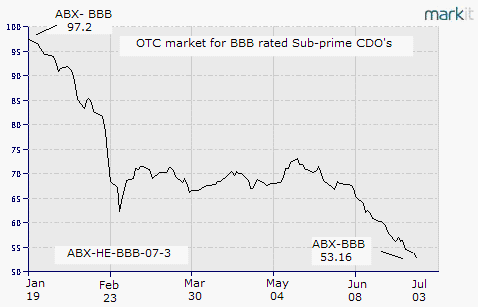
The fallout from the slide in sub-prime ABX's is uncertain, but if left unchecked, tighter lending standards could sink the US home building sector and housing prices, which were 2.7% lower, in May from a year earlier. Foreign currency traders are already upping their bets that the Bernanke Fed will continue its clandestine policy of injecting more US dollars into the banking system, and eventually lower the fed funds rate in a crisis situation. Coupled with the likelihood higher rates overseas, yet another global exodus from the US dollar has been set in motion.
In retrospect, it was Bernanke's infamous comments in a letter to California Rep Brad Sherman, dated Feb 15th, 2006 which began the dollar's latest 18-month descent. “A precipitous decline in the dollar, should not necessarily disrupt financial markets, production or employment,” Bernanke wrote, portending the central bank's rapid increase in the growth rate of the US money supply.
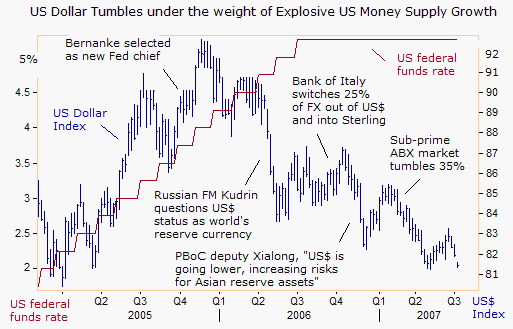
Two months later, Russian finance chief Alexei Kudrin put the knife into the US dollar, by telling the IMF that Moscow could not consider the dollar as a reliable reserve currency because of its instability. “This currency has devalued by 40% against the Euro in recent years. The US dollar is not the world's absolute reserve currency. The unsustainable US trade deficit is causing concern and that the international community can hardly be satisfied with this instability,” Kudrin told a stunned audience of the world's top central bankers in April 2006.
On November 24th, 2006, Chinese deputy central bank governor Wu Xiaoling warned “The exchange rate of the US dollar, which is the major reserve currency, is going lower, increasing the depreciation risk for east Asian reserve assets.”
Russian Bear aligned with “Axis of Oil” meets President Bush
Russian kingpin Vladimir Putin has been a notorious bear on the US dollar for the past few years, and is a key member of the “Axis of Oil” including American foes Iran's Mahmoud Ahmadinejad and Venezuela's Hugo Chavez. All three members of the “Axis of Oil” have been switching their FX reserves away from the US dollar and switching into Euros.
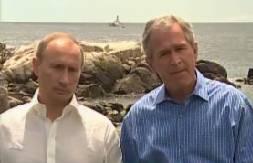 At a two-day meeting in Kennebunkport, Maine, Bush called Putin, “solid partner,” and added that “Russia has made amazing progress in such a short period of time,” since Soviet Union collapsed in 1991. “Russia is a country with no debt, and it's a significant international player. Is it perfect in the eyes of America? Not necessarily. Is the change real? Absolutely,” Bush said. Putin responded by saying, “The deck's been dealt and we are here to play. I would very much hope that we are playing one and the same game.”
At a two-day meeting in Kennebunkport, Maine, Bush called Putin, “solid partner,” and added that “Russia has made amazing progress in such a short period of time,” since Soviet Union collapsed in 1991. “Russia is a country with no debt, and it's a significant international player. Is it perfect in the eyes of America? Not necessarily. Is the change real? Absolutely,” Bush said. Putin responded by saying, “The deck's been dealt and we are here to play. I would very much hope that we are playing one and the same game.”
At the core of their disputes however, is Putin's alignment with Iran's Ayatollah Khamenei, his support for Iran's nuclear program, and Moscow's opposition to further UN sanctions on Tehran, which could wreak havoc on Iran's economy. Putin also opposes Bush's plan to create a European-based missile-defense system with radar based in the Czech Republic and interceptors based in Poland.
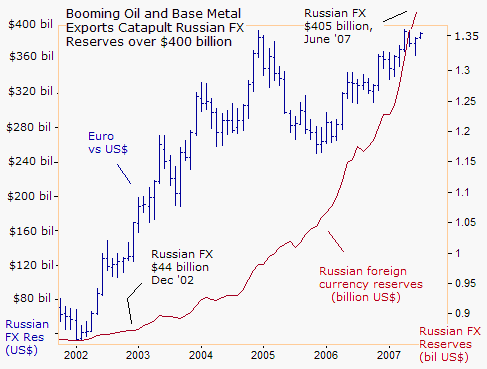
Russia is the world's largest natural gas producer, and is second to Saudi Arabia as the world's top crude oil exporter. Rising oil and base metal prices have enabled Russia to amass foreign currency reserves of $405 billion, the third largest after China and Japan. Russia's economy expanded at a 7.7% annualized rate in the first five months of this year, while the US economy grew at only 0.7% in Q'1, or a tenth of Russia's performance.
On April 6th, 2007, Russian central bank chief Sergei Ignatyev said the approximate structure of Russia's foreign exchange reserves was 50% in US dollars, 40% Euros, and 10% in British pounds. Last year, Putin ordered payments for Russia's Ural oil exports in rubles, abandoning the US dollar as a medium of payment. Iran's Ahmadinejad has ordered payment for Iranian oil exports in Euros.
Higher oil prices would increase the wealth the “Axis of Oil” and the clout of the Arab Oil kingdoms in the Persian Gulf, which control an estimated $1.6 trillion of FX reserves, outstripping the Chinese dragon. One has to wonder what impact a possible military confrontation over Iran's nuclear weapons program would have on the foreign exchange market.
For additional commentaries and market analysis, consider a subscription to the Global Money Trends newsletter, published on Friday, for 44 issues per year!
By Gary Dorsch,
Editor, Global Money Trends newsletter
http://www.sirchartsalot.com
Out-of-the box analysis and predictions for the (1) top-10 stock markets around the world, Exchange Traded Funds, and US home-builder indexes (2) Commodities such as crude oil, copper, gold, silver, the DJ Commodity Index, and gold mining and oil company indexes (3) Foreign currencies such as, the Australian dollar, British pound, Euro, Japanese yen, and Canadian dollar (4) Libor interest rates, global bond markets and central bank monetary policies, (5) Central banker "Jawboning" and Intervention techniques that move markets.
GMT filters important news and information into (1) bullet-point, easy to understand analysis, (2) featuring "Inter-Market Technical Analysis" that visually displays the dynamic inter-relationships between foreign currencies, commodities, interest rates and the stock markets from a dozen key countries around the world. Also included are (3) charts of key economic statistics of foreign countries that move markets.
A subscription to Global Money Trends is offered at only $150 US dollars per year for “44 weekly issues”, including access to all back issues. Click on the following hyperlink, to order now, http://www.sirchartsalot.com/newsletters.php Call toll free from USA to order, Sunday thru Thursday, 2 am to 4 pm EST, at 866-576-7872.
Mr Dorsch worked on the trading floor of the Chicago Mercantile Exchange for nine years as the chief Financial Futures Analyst for three clearing firms, Oppenheimer Rouse Futures Inc, GH Miller and Company, and a commodity fund at the LNS Financial Group.
As a transactional broker for Charles Schwab's Global Investment Services department, Mr Dorsch handled thousands of customer trades in 45 stock exchanges around the world, including Australia, Canada, Japan, Hong Kong, the Euro zone, London, Toronto, South Africa, Mexico, and New Zealand, and Canadian oil trusts, ADR's and Exchange Traded Funds.
He wrote a weekly newsletter from 2000 thru September 2005 called, "Foreign Currency Trends" for Charles Schwab's Global Investment department, featuring inter-market technical analysis, to understand the dynamic inter-relationships between the foreign exchange, global bond and stock markets, and key industrial commodities.
Copyright © 2005-2007 SirChartsAlot, Inc. All rights reserved.
Disclaimer: SirChartsAlot.com's analysis and insights are based upon data gathered by it from various sources believed to be reliable, complete and accurate. However, no guarantee is made by SirChartsAlot.com as to the reliability, completeness and accuracy of the data so analyzed. SirChartsAlot.com is in the business of gathering information, analyzing it and disseminating the analysis for informational and educational purposes only. SirChartsAlot.com attempts to analyze trends, not make recommendations. All statements and expressions are the opinion of SirChartsAlot.com and are not meant to be investment advice or solicitation or recommendation to establish market positions. Our opinions are subject to change without notice. SirChartsAlot.com strongly advises readers to conduct thorough research relevant to decisions and verify facts from various independent sources.
© 2005-2022 http://www.MarketOracle.co.uk - The Market Oracle is a FREE Daily Financial Markets Analysis & Forecasting online publication.


